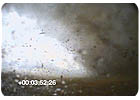
In frames from the actual surveillance video produced by the KT&C camera inside the probe, Tim Samaras can be seen in silhouette estimating probe placement before the tornado passes over.
PHOTO COPYRIGHT © TIM SAMARAS
PHOTO COPYRIGHT © TIM SAMARAS
Looking like it crash-landed from the merry old land of Oz, a series of seven surveillance video cameras inside a bright orange steel probe shaped like a flattened space capsule, withstood a tornado to deliver the first-ever video at ground level – just 10 feet from the tornado’s eye.

In frames from the actual surveillance video produced by the KT&C camera inside the probe, Tim Samaras can be seen in silhouette estimating probe placement before the tornado passes over.
PHOTO COPYRIGHT © TIM SAMARAS
PHOTO COPYRIGHT © TIM SAMARAS

In frames from the actual surveillance video produced by the KT&C camera inside the probe, Tim Samaras can be seen in silhouette estimating probe placement before the tornado passes over.
PHOTO COPYRIGHT © TIM SAMARAS
PHOTO COPYRIGHT © TIM SAMARAS

In frames from the actual surveillance video produced by the KT&C camera inside the probe, Tim Samaras can be seen in silhouette estimating probe placement before the tornado passes over.
PHOTO COPYRIGHT © TIM SAMARAS
PHOTO COPYRIGHT © TIM SAMARAS

In frames from the actual surveillance video produced by the KT&C camera inside the probe, Tim Samaras can be seen in silhouette estimating probe placement before the tornado passes over.
PHOTO COPYRIGHT © TIM SAMARAS
PHOTO COPYRIGHT © TIM SAMARAS
Freezing the debris’ movement was crucial to using a technique called photogrammetry to calculate the wind speeds at ground level inside the tornado. “You can see the veins of leaves as they fly past,†he pointed out.

In frames from the actual surveillance video produced by the KT&C camera inside the probe, Tim Samaras can be seen in silhouette estimating probe placement before the tornado passes over.
PHOTO COPYRIGHT © TIM SAMARAS
PHOTO COPYRIGHT © TIM SAMARAS
Samaras measured the distance a stick of debris traveled during the 16.6 milliseconds between its two appearances in successive video frames of the same camera to estimate the wind speed.

The unique shape of the probe prevented it from being lifted into the tornado that passed over it.
PHOTO COURTESY OF KT&C
PHOTO COURTESY OF KT&C
The probe, which is made of one-quarter-inch steel, has seven mini-DV recorders on the bottom of it underneath the cameras, which peer through windows of half-inch Lexan. One camera points directly up.
The entire probe weighs 85 pounds and is hermetically sealed and waterproof. A single switch turns on all the cameras and hard drives.

The KPC 650 CH high-resolution color analog camera from KT&C, Los Angeles, was selected for its size and fast shutter speed. PHOTO COURTESY OF KT&C
For more information, visitwww.thunderchase.com. For information about KT&C’s products, visitwww.ktncusa.comor call (888) 767-CCTV.


